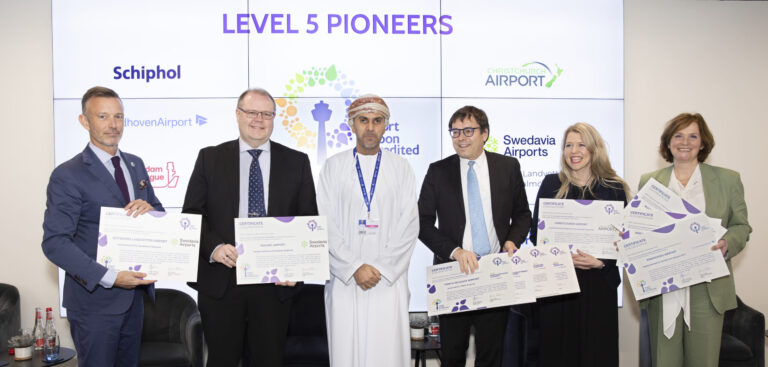
Olivier Jankovec, director general of ACI Europe, speaks to Passenger Terminal Today to reveal more about his presentation – “Airport climate action scales new heights with Level 5″ – on Day 2 at Passenger Terminal Conference 2024 (April 16, 17, 18) in Frankfurt, Germany, next month.
What is your presentation about?
In December 2023, ACI launched a brand-new, topmost level of Airport Carbon Accreditation – Level 5. This new level certifies airports for achieving a net-zero carbon balance for emissions under the airport’s direct control and committing to net zero for Scope 3 emissions by 2050 or sooner.
The expanded framework of the global carbon standard for airports now empowers the sector’s ambitious net-zero commitments and provides a global benchmark for net zero achievements. At the time of the launch, which took place at COP28 in Dubai, 10 airports had met all the stringent requirements of this new level as part of the pilot program. My presentation will provide you with everything you need to know about this trailblazing development in airport carbon management.
What will the key takeaways be for the audience?
The audience will gain insights into the process we’ve gone through to develop Level 5. Spoiler alert – it was not an easy feat! I will also take you on a brief walk through the history of the program and its constant evolution in line with climate science and also meeting the ever-expanding climate ambition of airports. We will discuss the importance of cooperation with all aviation stakeholders, as clearly, Scope 3 emissions are the next frontier in airport carbon management. Level 5 requires airports to commit to reaching net zero for Scope 3 emissions by 2050 – now it’s about finding ways to achieve this daunting goal hand in glove with our partners!
What led ACI to launch one more level of the Airport Carbon Accreditation program?
The introduction of Level 5 builds on the program’s trajectory of constant evolution. One of Airport Carbon Accreditation’s key strengths is its adaptability and forward-thinking approach. The previous structural change – the addition of Levels 4/4+ in 2020 – led airports to fully align their carbon management with the goals of the Paris Agreement, shifting focus to absolute emissions reductions and working toward an ambitious carbon reduction target with measurable goalposts along the way.
Today, more than 70 airports globally hold accreditation at one of those levels. In addition, in 2021 the global airport industry officially committed to reaching net-zero carbon emissions by 2050 – a pledge spearheaded by the Airports Council International confederation. We had the direction, but we needed a blueprint to get there. Enter Level 5 and its rigorous framework designed to push the boundaries of what’s achievable in airport carbon management all the way to net-zero carbon balance.
In your opinion, what are the most effective ways for airports to reach net zero for Scope 3 emissions?
Airports have a key role to play in accelerating decarbonization across the aviation ecosystem. As the one place on the ground where all the partners and stakeholders come together, they are the natural central node and facilitator of across-the-board climate action. Addressing Scope 3 is embedded into the Airport Carbon Accreditation recipe for effective carbon management from Level 3 upwards. Airports need to draw up stakeholder engagement plans and move to more established partnerships with third parties active within their premises as they progress to higher levels within the program.
In terms of practical solutions, ACI Europe has developed a dedicated guidance document on Airports’ Contribution to Net Zero Aviation. But to name a few core initiatives, I would mention: the electrification of ground support equipment; the facilitation of SAF availability and uptake; enabling sustainable landing and take-off cycles; the modulation of airport charges based on CO2 emissions or new aircraft technology; incentives to use biofuel in ground handling; and providing eGPUs [electric ground power units] and PCA [preconditioned air units] for aircraft on stand.
What emerging technology is playing a key role in these considerations?
Technological progress is of paramount importance for aviation to be able to decarbonize fully by 2050. According to our European-wide aviation net-zero roadmap, named Destination 2050, improvements in aircraft and engine technologies could account for up to a 37% reduction in carbon emissions from aviation within that timeframe.
The advent of hybrid-electric, electric and hydrogen-powered aircraft still requires a lot of R&D to yield the results we are hoping for. However, innovation is also key in other areas of climate action. New types of sustainable aviation fuels (i.e. power to liquid and e-fuels) still need to be fine-tuned from a technology standpoint for us to be able to scale them and use their full decarbonization potential.
Similarly, airports invest in innovation to seek out new ways to curb carbon emissions linked to air transport. These range from developing sustainable e-taxiing processes and investing in more sustainable materials for their infrastructure projects, to advancing the development of infrastructure for the turnaround of electric aircraft. Innovation has always been at the core of our industry and with climate change being the mother of all challenges for aviation, we are unleashing every innovative pathway at our disposal to address it.
To register for your Passenger Terminal Conference pass, please click here.


